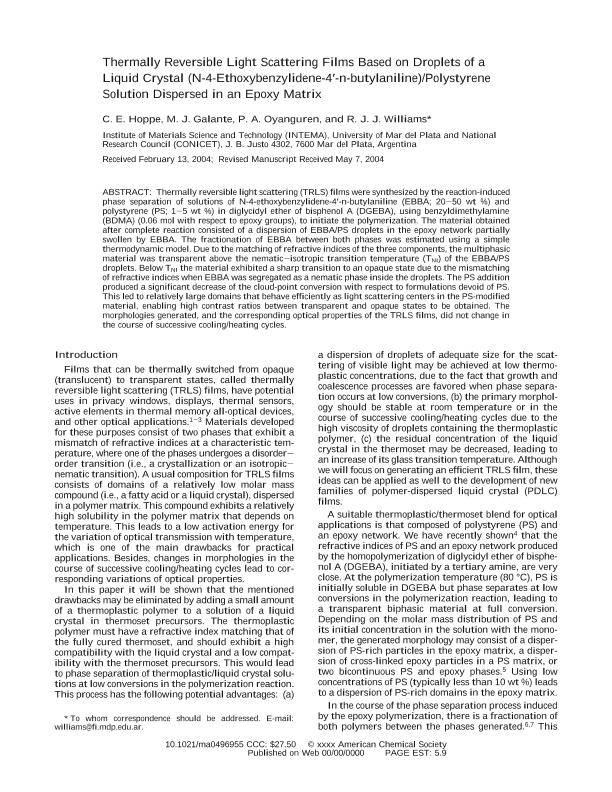Artículo
Thermally reversible light scattering films based on droplets of a liquid crystal (N-4-ethoxybenzylidene-4′-n-butylaniline)/polystyrene solution dispersed in an epoxy matrix
Hoppe, Cristina Elena ; Galante, Maria Jose
; Galante, Maria Jose ; Oyanguren, Patricia Angelica
; Oyanguren, Patricia Angelica ; Williams, Roberto Juan Jose
; Williams, Roberto Juan Jose
 ; Galante, Maria Jose
; Galante, Maria Jose ; Oyanguren, Patricia Angelica
; Oyanguren, Patricia Angelica ; Williams, Roberto Juan Jose
; Williams, Roberto Juan Jose
Fecha de publicación:
07/2004
Editorial:
American Chemical Society
Revista:
Macromolecules
ISSN:
0024-9297
Idioma:
Inglés
Tipo de recurso:
Artículo publicado
Clasificación temática:
Resumen
Thermally reversible light scattering (TRLS) films were synthesized by the reaction-induced phase separation of solutions of N-4-ethoxybenzylidene- 4′-n-butylaniline (EBBA; 20-50 wt %) and polystyrene (PS; 1-5 wt %) in diglycidyl ether of bisphenol A (DGEBA), using benzyldimethylamine (BDMA) (0.06 mol with respect to epoxy groups), to initiate the polymerization. The material obtained after complete reaction consisted of a dispersion of EBBA/PS droplets in the epoxy network partially swollen by EBBA. The fractionation of EBBA between both phases was estimated using a simple thermodynamic model. Due to the matching of refractive indices of the three components, the multiphasic material was transparent above the nematic-isotropic transition temperature (TNI) of the EBBA/PS droplets. Below TNI the material exhibited a sharp transition to an opaque state due to the mismatching of refractive indices when EBBA was segregated as a nematic phase inside the droplets. The PS addition produced a significant decrease of the cloud-point conversion with respect to formulations devoid of PS. This led to relatively large domains that behave efficiently as light scattering centers in the PS-modified material, enabling high contrast ratios between transparent and opaque states to be obtained. The morphologies generated, and the corresponding optical properties of the TRLS films, did not change in the course of successive cooling/heating cycles.
Palabras clave:
PDLC
,
Polystyrene
,
Epoxy
Archivos asociados
Licencia
Identificadores
Colecciones
Articulos(INTEMA)
Articulos de INST.DE INV.EN CIENCIA Y TECNOL.MATERIALES (I)
Articulos de INST.DE INV.EN CIENCIA Y TECNOL.MATERIALES (I)
Citación
Hoppe, Cristina Elena; Galante, Maria Jose; Oyanguren, Patricia Angelica; Williams, Roberto Juan Jose; Thermally reversible light scattering films based on droplets of a liquid crystal (N-4-ethoxybenzylidene-4′-n-butylaniline)/polystyrene solution dispersed in an epoxy matrix; American Chemical Society; Macromolecules; 37; 14; 7-2004; 5352-5357
Compartir
Altmétricas



